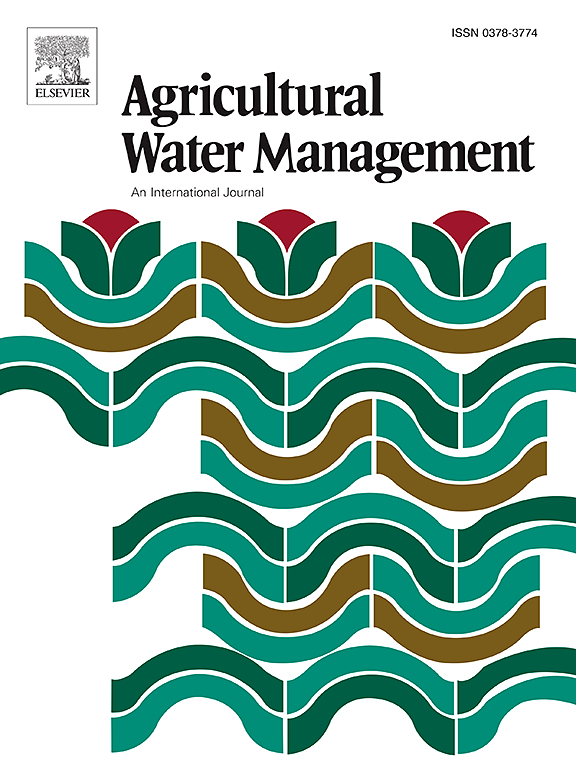模拟乌兹别克斯坦半干旱气候下棉花生长的AquaCrop模型的校准和验证
IF 6.5
1区 农林科学
Q1 AGRONOMY
引用次数: 0
摘要
棉花是一种重要的纤维作物,但其传统的生产方法非常耗水。在水资源供应已经限制棉花产量的地区,越来越需要探索在稳定产量的同时减少灌溉需求的替代田间管理方法。作物模型,如AquaCrop模型,在这些工作中发挥了重要作用,可以模拟田间管理、水动力学、作物生长和产量之间复杂的相互作用。然而,在AquaCrop棉花研究中报告的校准参数值的可变性引起了对先前校准模型的可转移性和可靠性的担忧。在本研究中,我们对联合国粮农组织(FAO)开发的AquaCrop作物模型进行了校准和验证,用于预测棉花的冠层生长、生物量积累和产量。这里制定的校准方案是相当保守的,严格遵守AquaCrop文档中提供的指导方针。每次处理的校准涉及大约150,000次模拟,采用蒙特卡罗(MC)协议系统地评估不同输入参数在多个评估标准中的影响,包括它们对水压力的影响。校准后的AquaCrop模型在模拟不同灌溉处理下的冠层生长、生物量积累和产量方面表现良好,达到可接受的水平,与以前的AquaCrop棉花应用相当。此外,MC协议还发现了模型中一个之前未被发现的错误,当最小生根深度设置在0.18 m以下时,该错误会在用户不知情的情况下将作物的种植日期更改约两周。此外,严格的校准协议清楚地描述了参数之间的补偿相互作用,其中一个参数的变化可以通过调整另一个参数来抵消,突出了试错校准方法中包含的主观性和局限性。本文章由计算机程序翻译,如有差异,请以英文原文为准。
Calibration and validation of the AquaCrop model for simulating cotton growth under a semi-arid climate in Uzbekistan
Cotton is a crucial fiber crop, but its conventional production methods are heavily water intensive. In regions where water availability already limits cotton yields, there is a growing need to explore alternative field management practices that stabilize yields while reducing irrigation demands. Crop models, such as the AquaCrop model, are instrumental in these efforts, enabling simulations of the complex interactions between field management, water dynamics, crop growth, and yield. However, the variability in calibrated parameter values reported across AquaCrop studies for cotton raises concerns about the transferability and reliability of previously calibrated models.
In this study, we calibrated and validated the AquaCrop crop model, developed by the Food and Agriculture Organization (FAO), to predict canopy growth, biomass accumulation and yield of cotton. The calibration protocol developed here is rather conservative, adhering strictly to the guidelines provided in the AquaCrop documentation. The calibration involved approximately 1500,000 simulations per treatment, employing a Monte Carlo (MC) protocol to systematically assess the effects of varying input parameters across multiple evaluation criteria, including their impact on water stress.
The calibrated AquaCrop model delivered good to acceptable performance levels in simulating canopy growth, biomass accumulation, and yield under various irrigation treatments, comparable to previous AquaCrop cotton applications. Additionally, the MC protocol uncovered a previously undiscover bug in the model, which shifted the crop’s planting date by approximately two weeks without user awareness, when the minimum rooting depth is set below 0.18 m. Furthermore, the rigorous calibration protocol clearly depicted compensatory interactions between parameters, where changes to one parameter can be offset by adjustments to another, highlighting the subjectivity and limitations encompassed in trial-and-error calibration approaches.
求助全文
通过发布文献求助,成功后即可免费获取论文全文。
去求助
来源期刊

Agricultural Water Management
农林科学-农艺学
CiteScore
12.10
自引率
14.90%
发文量
648
审稿时长
4.9 months
期刊介绍:
Agricultural Water Management publishes papers of international significance relating to the science, economics, and policy of agricultural water management. In all cases, manuscripts must address implications and provide insight regarding agricultural water management.
 求助内容:
求助内容: 应助结果提醒方式:
应助结果提醒方式:


